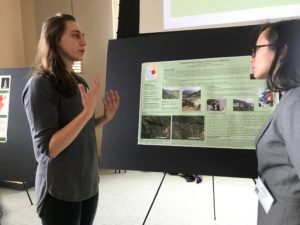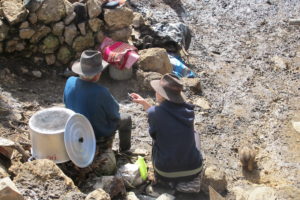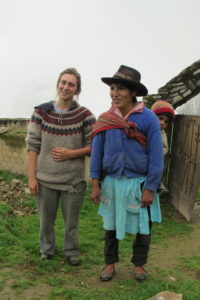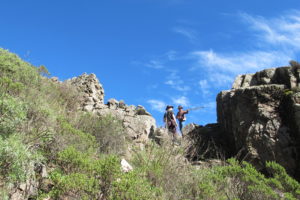submitted by Sofia Benito Alston (’21), UVM Anthropology CommTeam
Sylvie Diana Littledale is this year’s recipient of the James B. Petersen Archaeology Award for an outstanding Anthropology graduate who is pursuing archaeology.

On April 16th, UVM celebrated its annual Student Research Conference where students get to discuss the research they have carried out. One of those students, Sylvie Diana Littledale, exhibited a poster on her fieldwork in to Peru and interactive maps she developed using GPS coordinates she collected throughout the trip. Her supervising professor Dr. Deborah Blom reported, “Sylvie’s experiences have been invaluable in helping her to advance the research skills and anthropological theory that she learned at UVM to address important questions in anthropology and ethnohistory alike. Her project has progressed from musings while abroad to a sophisticated and engaging thesis-length manuscript.”
After taking classes at UVM, Sylvie’s research began the summer after freshman year, in 2015, when she travelled down to Zaña, Peru with then UVM professor Dr. Parker Van Valkenburgh to work on his excavation site. She spent 2½ months there, during which time she met and worked with archaeologist Bradymir Bravo Meza. A year later, during her semester abroad in Argentina, she met with a colleague from Huarochirí and carried out archaeological surveys for a month. It was then she was first introduced to the Huarochiri Manuscript. The author is unknown, but speculated to be an indigenous scribe who wrote in Quechua using the Spanish alphabet. It is just very rare that a document of this type was written and survived. It records oral histories such as myths, customs, festivals, conflicts and a rich geographical description of the area and terrain. While Sylvie worked on the survey, she got to know the geography of the region and its many archaeological sites.
Sylvie’s fieldwork also allowed her to get to know the locals in the area, and she has been returning to this spot since 2016. Throughout the years, Sylvie began to form her own research project to collect oral traditions about place in different areas. Her original idea was to map the stories told to her, linking them to the Huarochirí manuscript, but the more time she spent getting to know the locals, the more her focus changed to modern legends. She worked in two villages with a total population of 47, including children, and spoke to all but one of the 29 adults there. Even though most stories told were told by more than one person, each individual had their own way of telling them. Everyone was open and welcoming to her, excited about the opportunity at hand. To quote her directly “I hope that my gratitude to the communities of San Pedro de Llancha and San Antonio de Chinchina and to my colleagues down there, especially Bravo Meza, is expressed.”

Now all this sounds beautiful and poetic, but it was two months of very hard work. Planning for a trip this big is no easy task, so when she finally landed in Peru her plans were still very up in the air. She ended up staying in the local school, which was closed for summer vacations and had no bathroom or kitchen. Her diet consisted of potatoes, rice and noodles so you can all imagine that this past year back at UVM she has steered clear of all three. It was also during the rainy season so the trips between villages, or down to the city, would sometimes be impossible. The thick fog and heavy rains completely enveloped the villages. There’s no doubt that it was a very transformative experience for Sylvie.
Sylvie’s four years at UVM were also spread out elsewhere throughout the world as she studied abroad in Spain, Argentina and Hong Kong. “I was working on my Spanish in the first two places, but was able to focus more on anthropology in Hong Kong which is where I took a class “Making Places: Landscapes, Culture and Society” that was  a big part of the inspiration to do the research I am doing now.” As Sylvie’s time at UVM is ending, an internship with UVM’s Consulting Archaeology Program (CAP), directed by anthropology Professor John Crock, has allowed her to build out her experience in the US. Sylvie is carrying out a variety of projects, including GIS training and working. “I worked cataloguing in the lab, I spent a lot of time working on processing data from previous sites in GIS, and I was able to go out in the field a few times.”
a big part of the inspiration to do the research I am doing now.” As Sylvie’s time at UVM is ending, an internship with UVM’s Consulting Archaeology Program (CAP), directed by anthropology Professor John Crock, has allowed her to build out her experience in the US. Sylvie is carrying out a variety of projects, including GIS training and working. “I worked cataloguing in the lab, I spent a lot of time working on processing data from previous sites in GIS, and I was able to go out in the field a few times.”
Sylvie will be graduating as a double major in Spanish and Anthropology, and will be moving to Utah to go to graduate school in Brigham Young University. The list of things she would like to do include doing more mapping, moving throughout Peru and working on doing a linguistic analysis. Here’s to a fantastic student that will be greatly missed!



Recent Comments